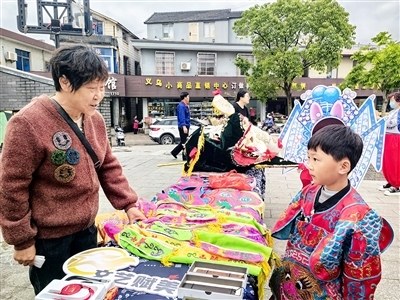In Chuanshan Village, Chaiqiao Sub-district, there is a kind of intangible cultural heritage called Chuanshan shoulder back play. On May 9, Lubei Community held an International Family Day themed event called "Parent-Child Immersive Experience of Intangible Cultural Heritage", with 15 groups of members of integrated social organizations invited. The market site is bustling with people. Unique projects such as farmer paintings, Chuanshan shoulder back play, intangible cultural heritage exhibition of performance featuring lions and elephants, intangible cultural heritage youth tour parent-child experience activities, and intangible cultural heritage visits have attracted a large number of residents to watch and participate.
“Chuanshan shoulder back play” is an ancient folk art with a history of more than 180 years since the 19th year of Daoguang in the Qing Dynasty (1839 AD), which used to be commonly seen in temple fairs and major celebrations. In this art, children aged about 10 act as various dramatic characters, standing on the shoulders of adults, simulating dramatic actions to the rhythm of gongs and drums, and singing, reading, acting and playing while dancing, with people above and below cooperate harmoniously, creating a lively atmosphere.
"Look, Mom, this dress is so beautiful." "Dad, the shape of this elephant is different from those I have seen before. What is it used for?" The children were curious about the costumes for shoulder back play and the props for performance featuring lions and elephants which they have never seen before. Zhou Cuizhu, the seventh generation inheritor of Chuanshan shoulder back play, interacted with the children enthusiastically, introduced the origin of Chuanshan shoulder back play and invited them to experience it on the spot.
At the activity site, the teacher led the children and parents to draw facial makeup together, and explained the classification, characteristics and colors of facial makeup in detail, as well as the unique personalities of the characters represented by each color. After listening to the teacher's introduction, everyone is eager to try, picked up the gouache brush to draw lines on the blank facial makeup, and painted evenly, looking forward to creating their own hand-painted facial makeup.
Subsequently, the children cooperated with their parents and carefully depicted the loyal and honest "red facial makeup", the serious and powerful "black facial makeup", the treacherous and suspicious "white facial makeup", and the rebellious and upright "blue facial makeup"... Soon, one after another vivid, interesting and colorful facial makeup appeared in front of everyone. Looking at their works, the children happily put on masks, shared with their parents, and posed different shapes for a group photo.
"The understanding of intangible cultural heritage should start from children's childhood. It is necessary to make intangible cultural heritage 'alive' and enter the vision of more people, so that more people can know and understand intangible cultural heritage and inherit it." said Zhou Cuizhu. (Journalist: Bao Ye; Correspondents: Ye Jingjing and Wu Yinyan)
